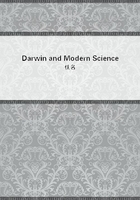
第198章
The meeting of the Geological Society on April 19th was devoted to the reading by Owen of his paper on Toxodon, perhaps the most remarkable of the fossil mammals found by Darwin in South America; and at the next meeting, on May 3rd, Darwin himself read "A Sketch of the Deposits containing extinct Mammalia in the neighbourhood of the Plata". The next following meeting, on May 17th, was devoted to Darwin's Coral-reef paper, entitled "On certain areas of elevation and subsidence in the Pacific and Indian Oceans, as deduced from the study of Coral Formations". Neither of these three early papers of Darwin were published in the Transactions of the Geological Society, but the minutes of the Council show that they were "withdrawn by the author by permission of the Council."Darwin's activity during this session led to some rather alarming effects upon his health, and he was induced to take a holiday in Staffordshire and the Isle of Wight. He was not idle, however, for a remark of his uncle, Mr Wedgwood, led him to make those interesting observations on the work done by earthworms, that resulted in his preparing a short memoir on the subject, and this paper, "On the Formation of Mould", was read at the Society on November 1st, 1837, being the first of Darwin's papers published in full; it appeared in Vol. V. of the "Geological Transactions", pages 505-510.)During this session, Darwin attended nearly all the Council meetings, and took such an active part in the work of the Society that it is not surprising to find that he was now requested to accept the position of Secretary. After some hesitation, in which he urged his inexperience and want of knowledge of foreign languages, he consented to accept the appointment. ("L.L." I. page 285.)At the anniversary meeting on February 16th, 1838, the Wollaston Medal was given to Owen in recognition of his services in describing the fossil mammals sent home by Darwin. In his address, the President, Professor Whewell, dwelt at length on the great value of the papers which Darwin had laid before the Society during the preceding session.
On March 7th, Darwin read before the Society the most important perhaps of all his geological papers, "On the Connexion of certain Volcanic Phenomena in South America, and on the Formation of Mountain-Chains and Volcanoes as the effect of Continental Elevations". In this paper he boldly attacked the tenets of the Catastrophists. It is evident that Darwin at this time, taking advantage of the temporary improvement in his health, was throwing himself into the breach of Uniformitarianism with the greatest ardour.
Lyell wrote to Sedgwick on April 21st, 1837, "Darwin is a glorious addition to any society of geologists, and is working hard and making way, both in his book and in our discussions." ("The Life and Letters of the Reverend Adam Sedgwick", Vol. I. page 484, Cambridge, 1890.)We have unfortunately few records of the animated debates which took place at this time between the old and new schools of geologists. I have often heard Lyell tell how Lockhart would bring down a party of friends from the Athenaeum Club to Somerset House on Geological nights, not, as he carefully explained, that "he cared for geology, but because he liked to while the fellows fight." But it fortunately happens that a few days after this last of Darwin's great field-days, at the Geological Society, Lyell, in a friendly letter to his father-in-law, Leonard Horner, wrote a very lively account of the proceedings while his impressions were still fresh; and this gives us an excellent idea of the character of these discussions.
Neither Sedgwick nor Buckland were present on this occasion, but we can imagine how they would have chastised their two "erring pupils"--more in sorrow than in anger--had they been there. Greenough, too, was absent--possibly unwilling to countenance even by his presence such outrageous doctrines.